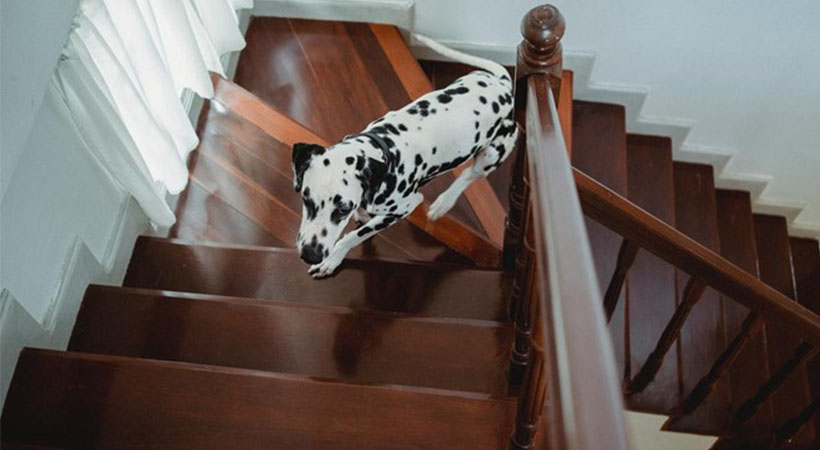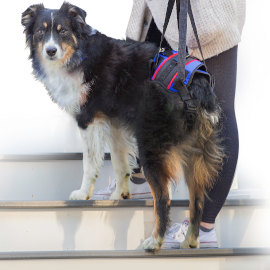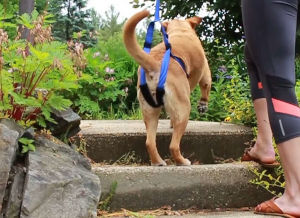- June 20, 2023
How to Train Your Pet to Use a Ramp or Stairs

If you’re a pet parent, you understand the unique challenges our furry friends can face in their daily lives. Whether it’s navigating a steep staircase or hopping into the car for a vet visit, these seemingly simple tasks can become daunting obstacles, especially for pets with mobility issues.
This is where pet ramps and stairs come into play. They’re fantastic tools that can make these tasks much easier and safer. But how do you train your pet to use them? Let’s dive in.
Understanding the Need for Ramps and Stairs

Ramps and stairs aren’t just convenient tools, they’re often necessary aids for pets – especially those with weak back legs. These aids can help your pet move around more easily and safely, reducing the risk of injury and improving their overall quality of life.
For pets with mobility issues, climbing stairs or jumping into a car can put a lot of strain on their joints. Over time, this can lead to pain, injury, and even long-term damage. Ramps and stairs can help alleviate this strain by providing a gentler, more manageable way for your pet to navigate these obstacles.
Ramps and stairs can also be beneficial for older pets or those recovering from surgery. They can help these pets maintain their independence while also ensuring they don’t overexert themselves or risk further injury.
Choosing Between a Ramp and Stairs
When it comes to choosing between a ramp and stairs for your pet, there are several factors to consider. Each pet is unique, and what works best for one might not work as well for another.
Firstly, consider your pet’s physical condition. For pets with joint issues or weak legs, a ramp might be a better choice as it provides a gradual incline that’s easier to navigate. On the other hand, stairs can be a good option for pets that are more agile and need a compact solution that can fit in smaller spaces.
Secondly, think about the specific situations where you’ll be using the aid. For instance, if you’re primarily using it to help your pet get into a car, a ramp might be more suitable. But if you’re looking for a solution to help your pet get up onto a bed or couch, stairs might be the better option.
Training Your Pet to Use a Ramp
Training your pet to use a ramp is a gradual process that begins with introducing the ramp in a flat position. This allows your pet to get used to walking on it. Encourage your pet to approach the ramp, sniff it, and walk on it. Reward them with treats and praise for any interaction with the ramp, creating a positive association.
Once your pet is comfortable with the ramp on the ground, you can start to gradually raise it. Begin with a slight incline and continue to reward your pet for using the ramp. This positive reinforcement will encourage them to continue using the ramp as the incline increases.
As your pet gains confidence, you can gradually increase the incline until it’s at the height they will typically use. Remember, patience is key. Some pets might take longer to get used to the ramp, and that’s okay. The important thing is to make the experience positive and stress-free.
Training Your Pet to Use Stairs

Training your pet to use stairs follows a similar slow and steady process as the ramp. Start with the bottom step, encouraging your pet to go up and down. Use treats and praise to reward them for their bravery, which will help build their confidence.
Once they’re comfortable with the bottom step, encourage them to climb up to the second step and then back down. Continue to use treats and positive reinforcement to make the experience enjoyable. This will help your pet associate the stairs with positive experiences, making them more likely to use them.
Gradually increase the number of steps as your pet gains confidence. Remember, patience is key. Don’t rush the process, and always ensure your pet is comfortable and not showing signs of stress or fear. With time and patience, your pet will become a pro at navigating the stairs.
Special Considerations for Dogs with Weak Back Legs
Dogs with weak back legs often face additional challenges when using ramps or stairs, such as difficulty gripping the surface or an inability to climb up and down. If your dog falls into this category, there are a few things you can do to help them:
- Use a ramp or stairs with textured surfaces. This will help your pet get a better grip and make the process easier.
- Start slow. Dogs with weak back legs may need more time to adjust to using ramps or stairs. Start with short, easy sessions and gradually increase the difficulty as your dog becomes more comfortable.
- Keep an eye out for signs of fatigue. When using ramps or stairs, dogs with weak back legs can become tired quickly. If you notice any signs of fatigue, take a break to let them rest and recover.
- Use a harness. A support or lifting harness can provide additional assistance for your dog, making it easier for them to navigate ramps or stairs.
- Consult with a professional. If your dog is struggling to use a ramp or stairs, it may be helpful to consult with a professional dog trainer or a veterinary physical therapist. They can provide personalized training strategies and help ensure your dog is using the aid safely.
Using a Support or Lifting Harness

A support or lifting harness can be a great tool to assist your dog on the stairs. These harnesses provide support and can help distribute your dog’s weight evenly, making it easier for them to move. Always ensure the harness is correctly fitted and comfortable for your dog, and never rush the process.
Here are some tips for using a harness:
- Choose the right harness. Make sure to choose a harness that’s the right size for your dog and provides adequate support. Some harnesses are designed specifically for dogs with mobility issues and provide additional support for the back legs.
- Introduce the harness slowly. Just like with the ramp or stairs, introduce the harness slowly. Let your dog sniff and explore the harness before you put it on them. Use treats and praise to create a positive association.
- Practice using the harness. Before you use the harness on the stairs or ramp, practice using it on flat ground. This can help your dog get used to the feeling of the harness and how it affects their movement.
What’s Next in Your Pet’s Training Journey?
Now that you know how to train your pet to use a ramp or stairs, it’s time to start practicing. Remember, patience and consistency are key. Every pet is unique, so it’s important to go at a pace that’s comfortable for your furry friend. With time and practice, your pet will be navigating their new ramp or stairs with ease! So, what’s the next step in your pet’s training journey?
Guest Author:
Richard Rowlands
Richard is a copywriter and content creator who works with pet and veterinary businesses. When he’s not researching, writing, or creating content plans, he enjoys spending time with his rescue dog, Otto, and exploring new places. Check out his blog for savvy pet parents at richardrowlands.com.
Related Articles:
Tags
What do you think?
Related Articles

New Puppy Checklist: Gear You’ll Need for Your New Dog
Getting a new puppy is really exciting, but before you welcome them home, it’s important to prepare your space for them. Since puppies need a

How Big Do Mini Poodles Get? Vet Reviewed Average Weight & Growth Chart – Dogster
The information is current and up-to-date in accordance with the latest veterinarian research. Learn more » When you buy a Miniature Poodle, you might not

Can Police Dogs Smell Nicotine? Vet Verified Facts & Info – Dogster
The information is current and up-to-date in accordance with the latest veterinarian research. Learn more » While cigarette sales have been declining steadily for decades,

How Old Is 5 in Dog Years? Vet-Approved Guide to Each Size of Dog – Dogster
The information is current and up-to-date in accordance with the latest veterinarian research. Learn more » A common method for calculating a dog’s age is

